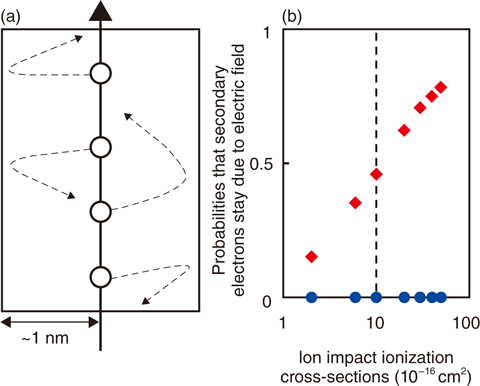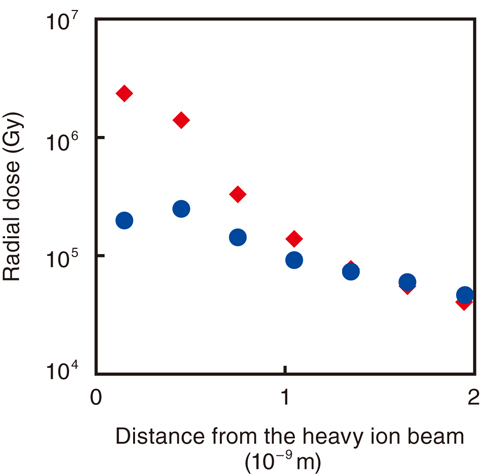
Fig.5-33 (a)Images of the movement of secondary electrons and (b) probabilities that secondary electrons stay near the heavy-ion path for various impact-ionization cross-sections

Fig.5-34 Radial dose vs. distance from the incident-ion path for the irradiation of 36-MeV carbon-ion beams into water
Heavy-particle cancer therapy is one of the most important techniques for realizing a healthy and long-living society because it offers a smaller exposure to normal tissues than do other forms of radiation therapy such as that using X-rays. This is because heavy ions can be directed only toward cancer cells. Secondary electrons, which are produced from the heavy-particle-impact ionization in the tissue (of which the main component is water), as well as the heavy particles (ions) themselves, significantly contribute to the dose. Therefore, it is important to estimate the radial dose (which is the dose as a function of distance from the heavy-ion path) produced by secondary electrons in planning heavy-particle cancer-therapy systems.
In order to simulate radial dose, firstly, we construct a model. Then, we make a simulation code using this model. Finally, we operate this code on the super-computers. Conventional models suffer from the weakness that electric fields formed from positive molecular ions are ignored because the continuum is treated as a target. To overcome this weakness, we treat individual molecules in the target and the Coulomb interaction between each individual molecular ion and each individual secondary electron. This allows our model to become closer to reality than conventional ones. We find that all secondary electrons move away from the heavy-ion path in the conventional model. However, numerous secondary electrons are trapped near this path (Fig.5-33(a)). We also find the probability of secondary electrons being trapped near this path increases with increasing ion-impact-ionization cross-sections (Fig.5-33(b)).
Fig.5-34 shows radial-dose distributions obtained from our proposed and the conventional models. In our simulations, the radial dose obtained from our model is approximately 10 times as large as that from the conventional model on the heavy-ion path. This may be owing to the secondary electrons trapped near the heavy-ion path interacting multiple times with the target molecules.
The present planning systems for heavy-particle cancer therapy employ a radial dose-distribution estimated in the μm-order region according to the sizes of the chromosomes. However, our simulation results indicate that it is important to estimate the radial dose distribution in the nm-order region, which corresponds to the size of the DNA. We will study the effect of DNA in the nm-sized region in more detail to advance this therapy.
This study was partly supported by the Japan Society for the Promotion of Science (JSPS) KAKENHI Grant-in-Aid for Scientific Research (C) (No.25390131).